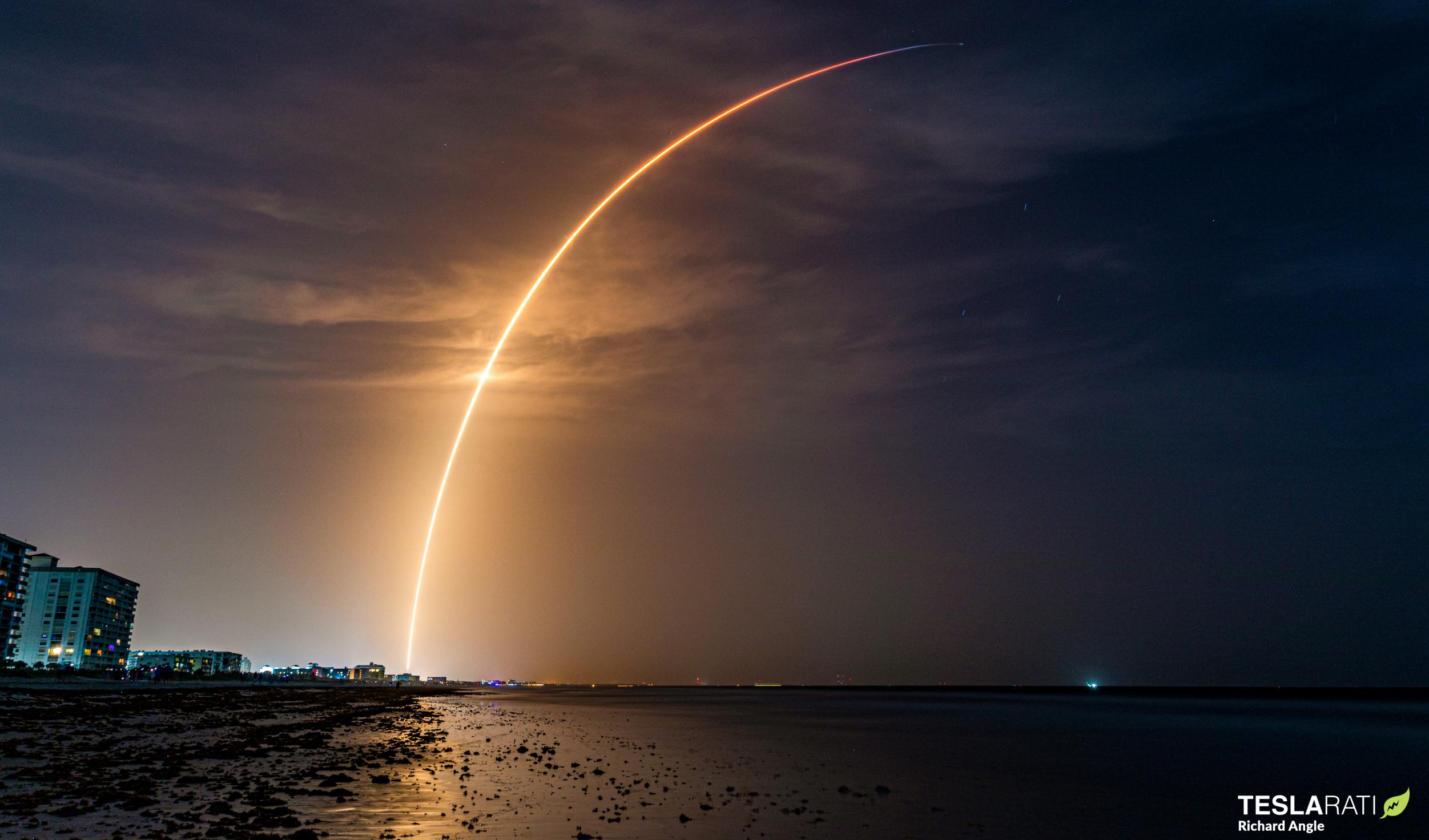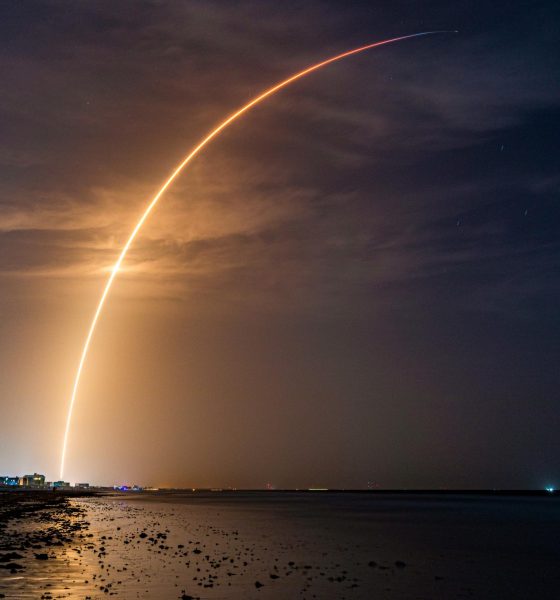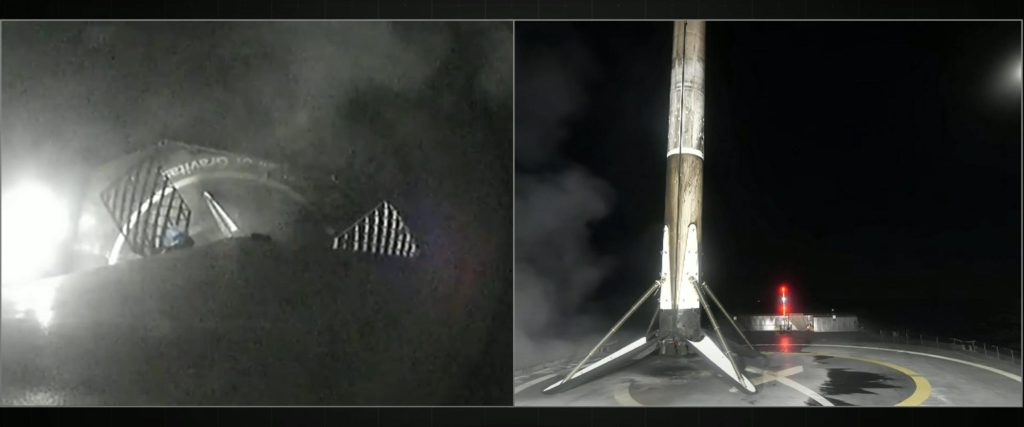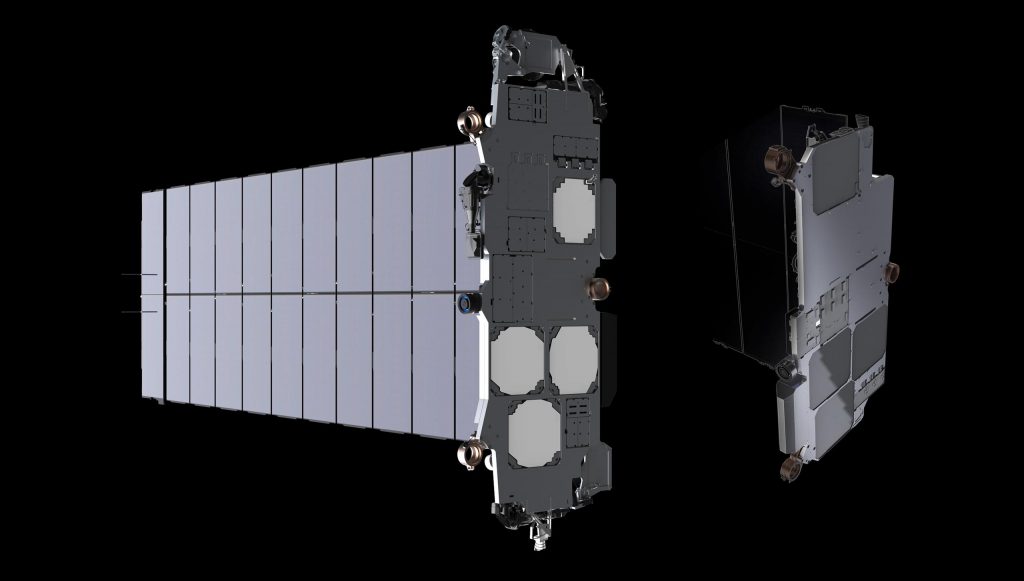

News
SpaceX launches 3000th Starlink satellite
SpaceX has successfully launched its 3000th Starlink satellite as part of Falcon 9’s 54th dedicated mission for the low Earth orbit (LEO) internet constellation.
After high upper-level winds forced SpaceX to call off a launch attempt three hours prior, Falcon 9 lifted off from NASA Kennedy Space Center (KSC) Launch Complex 39A at 10:14 pm EDT (02:14 UTC), carrying another 52 new Starlink V1.5 satellites inside the rocket’s flight-proven payload fairing. Like the fairing halves, both of which had already supported two orbital-class launches, the Falcon 9 booster (B1073) SpaceX assigned to the mission was also flying for the third time.
For the most part, Falcon 9 performed nominally. The booster lifted an expendable upper stage and the enclosed payload most of the way out of Earth’s atmosphere before separating and heading back to Earth. Falcon 9’s upper stage was as perfect as ever, boosting the Starlink stack the rest of the way into a low and elliptical parking orbit, where it eventually spun itself end over end and deployed all 52 satellites at once.
Falcon 9 booster B1073 made it through its reentry and landing burns without issue and safely touched down on drone ship A Shortfall Of Gravitas (ASOG) about nine minutes after liftoff. While that landing was ultimately a success, B1073’s accuracy was not exactly flawless and the booster came to a halt with two of its four legs unusually close to the edge of the drone ship’s deck. Had the booster missed the bullseye by just 5-10 more feet, it could have easily landed with one or two feet off the deck and tipped into the Atlantic.
Nonetheless, the landing was successful and SpaceX should have no issue recovering the booster. In any other context, it would barely be worth noting, but flawless Starlink launches with near-bullseye landings have become such a frequent and routine occurrence that any departure from that norm has become interesting.

Starlink 4-26 (referring to the 26th batch of Group or Shell 4 satellites) was SpaceX’s 54th dedicated Starlink launch overall and 21st Starlink launch in 2022 alone. The mission also carried SpaceX’s 3000th Starlink satellite into orbit, a milestone so far removed from the next largest satellite constellation that it’s now more reasonable to compare Starlink to every other satellite currently in orbit. Of the 3009 Starlink satellites SpaceX has now successfully launched since 2018, 2750 are still in orbit. Assuming all 52 Starlink 4-26 satellites are healthy, astrophysicist and space object tracker Jonathan McDowell estimates that SpaceX has 2714 working satellites in orbit.
Excluding 75 prototype satellites launched over the years, all but 5 of which have since deorbited, 92.3% of all operational Starlink satellites launched by SpaceX since November 2019 are still working in orbit. While Starlink V1.0’s 7.7% satellite failure rate is far from desirable, SpaceX has made clear progress with its V1.5 design, which began launching in September 2021. Excluding 38 satellites that were lost when a solar storm caused Earth’s atmosphere to expand, unexpectedly increasing drag to uncontrollable levels, only 10 of the 1218 Starlink V1.5 satellites SpaceX has launched have failed and prematurely reentered for technical reasons – a failure rate of 0.9%.

If SpaceX’s V1.5 satellites continue to demonstrate excellent reliability as they reach ages similar to their V1.0 predecessors, it will bode well for the sustainability and predictability of current and future Starlink constellations. Meanwhile, the roughly 2270 Starlink satellites that are currently operational continue to deliver internet services to hundreds of thousands of customers in countries around the world, improving the lives of countless people.
According to Next Spaceflight, SpaceX has up to five more Starlink launches scheduled this month as it continues to relentlessly pursue a record-breaking launch cadence with its Falcon 9 rocket. Up next, Starlink 3-3 could launch from California as early as August 12th. Photographer Ben Cooper reports that another East Coast Starlink mission is working towards a “mid-August” launch soon after.

News
Tesla China delivery centers look packed as 2025 comes to a close
Needless to say, it appears that Tesla China seems intent on ending 2025 on a strong note.

Tesla’s delivery centers in China seem to be absolutely packed as the final days of 2025 wind down, with photos on social media showing delivery locations being filled wall-to-wall with vehicles waiting for their new owners.
Needless to say, it appears that Tesla China seems intent on ending 2025 on a strong note.
Full delivery center hints at year-end demand surge
A recent image from a Chinese delivery center posted by industry watcher @Tslachan on X revealed rows upon rows of freshly prepared Model Y and Model 3 units, some of which were adorned with red bows and teddy bears. Some customers also seem to be looking over their vehicles with Tesla delivery staff.
The images hint at a strong year-end push to clear inventory and deliver as many vehicles as possible. Interestingly enough, several Model Y L vehicles could be seen in the photos, hinting at the demand for the extended wheelbase-six seat variant of the best-selling all-electric crossover.
Strong demand in China
Consumer demand for the Model Y and Model 3 in China seems to be quite notable. This could be inferred from the estimated delivery dates for the Model 3 and Model Y, which have been extended to February 2026 for several variants. Apart from this, the Model Y and Model 3 also continue to rank well in China’s premium EV segment.
From January to November alone, the Model Y took China’s number one spot in the RMB 200,000-RMB 300,000 segment for electric vehicles, selling 359,463 units. The Model 3 sedan took third place, selling 172,392. This is quite impressive considering that both the Model Y and Model 3 are still priced at a premium compared to some of their rivals, such as the Xiaomi SU7 and YU7.
With delivery centers in December being quite busy, it does seem like Tesla China will end the year on a strong note once more.
News
Tesla Giga Berlin draws “red line” over IG Metall union’s 35-hour week demands
Factory manager André Thierig has drawn a “red line” against reducing Giga Berlin’s workweek to 35 hours, while highlighting that Tesla has actually increased its workers’ salaries more substantially than other carmakers in the country.

Tesla Giga Berlin has found itself in a new labor dispute in Germany, where union IG Metall is pushing for adoption of a collective agreement to boost wages and implement changes, such as a 35-hour workweek.
In a comment, Giga Berlin manager André Thierig drew a “red line” against reducing Giga Berlin’s workweek to 35 hours, while highlighting that Tesla has actually increased its workers’ salaries more substantially than other carmakers in the country.
Tesla factory manager’s “red line”
Tesla Germany is expected to hold a works council election in 2026, which André Thierig considers very important. As per the Giga Berlin plant manager, Giga Berlin’s plant expansion plans might be put on hold if the election favors the union. He also spoke against some of the changes that IG Metall is seeking to implement in the factory, like a 35-hour week, as noted in an rbb24 report.
“The discussion about a 35-hour week is a red line for me. We will not cross it,” Theirig said.
“(The election) will determine whether we can continue our successful path in the future in an independent, flexible, and unbureaucratic manner. Personally, I cannot imagine that the decision-makers in the USA will continue to push ahead with the factory expansion if the election results favor IG Metall.”
Giga Berlin’s wage increase
IG Metall district manager Jan Otto told the German news agency DPA that without a collective agreement, Tesla’s wages remain significantly below levels at other German car factories. He noted the company excuses this by referencing its lowest pay grade, but added: “The two lowest pay grades are not even used in car factories.”
In response, Tesla noted that it has raised the wages of Gigafactory Berlin’s workers more than their German competitors. Thierig noted that with a collective agreement, Giga Berlin’s workers would have seen a 2% wage increase this year. But thanks to Tesla not being unionized, Gigafactory Berlin workers were able to receive a 4% increase, as noted in a CarUp report.
“There was a wage increase of 2% this year in the current collective agreement. Because we are in a different economic situation than the industry as a whole, we were able to double the wages – by 4%. Since production started, this corresponds to a wage increase of more than 25% in less than four years,” Thierig stated.
News
Tesla is seeing a lot of momentum from young Koreans in their 20s-30s: report
From January to November, young buyers purchased over 21,000 Teslas, putting it far ahead of fellow imported rivals like BMW and Mercedes-Benz.

Tesla has captured the hearts of South Korea’s 20s-30s demographic, emerging as the group’s top-selling imported car brand in 2025. From January to November, young buyers purchased over 21,000 Teslas, putting it far ahead of fellow imported rivals like BMW and Mercedes-Benz.
Industry experts cited by The Economist attributed this “Tesla frenzy” to fandom culture, where buyers prioritize the brand over traditional car attributes, similar to snapping up the latest iPhone.
Model Y dominates among young buyers
Data from the Korea Imported Automobile Association showed that Tesla sold 21,757 vehicles to the 20s-30s demographic through November, compared to BMW’s 13,666 and Mercedes-Benz’s 6,983. The Model Y led the list overwhelmingly, with variants like the standard and Long Range models topping purchases for both young men and women.
Young men bought around 16,000 Teslas, mostly Model Y (over 15,000 units), followed by Model 3. Young women followed a similar pattern, favoring Model Y (3,888 units) and Model 3 (1,083 units). The Cybertruck saw minimal sales in this group.
The Model Y’s appeal lies in its family-friendly SUV design, 400-500 km range, quick acceleration, and spacious cargo, which is ideal for commuting and leisure. The Model 3, on the other hand, serves as an accessible entry point with lower pricing, which is valuable considering the country’s EV subsidies.
The Tesla boom
Experts described Tesla’s popularity as “fandom culture,” where young buyers embrace the brand despite criticisms from skeptics. Professor Lee Ho-geun called Tesla a “typical early adopter brand,” comparing purchases to iPhones.
Professor Kim Pil-soo noted that young people view Tesla more as a gadget than a car, and they are likely drawn by marketing, subsidies, and perceived value. They also tend to overlook news of numerous recalls, which are mostly over-the-air software updates, and controversies tied to the company.
Tesla’s position as Korea’s top import for 2025 seems secured. As noted by the publication, Tesla’s December sales figures have not been reported yet, but market analysts have suggested that Tesla has all but secured the top spot among the country’s imported cars this year.








